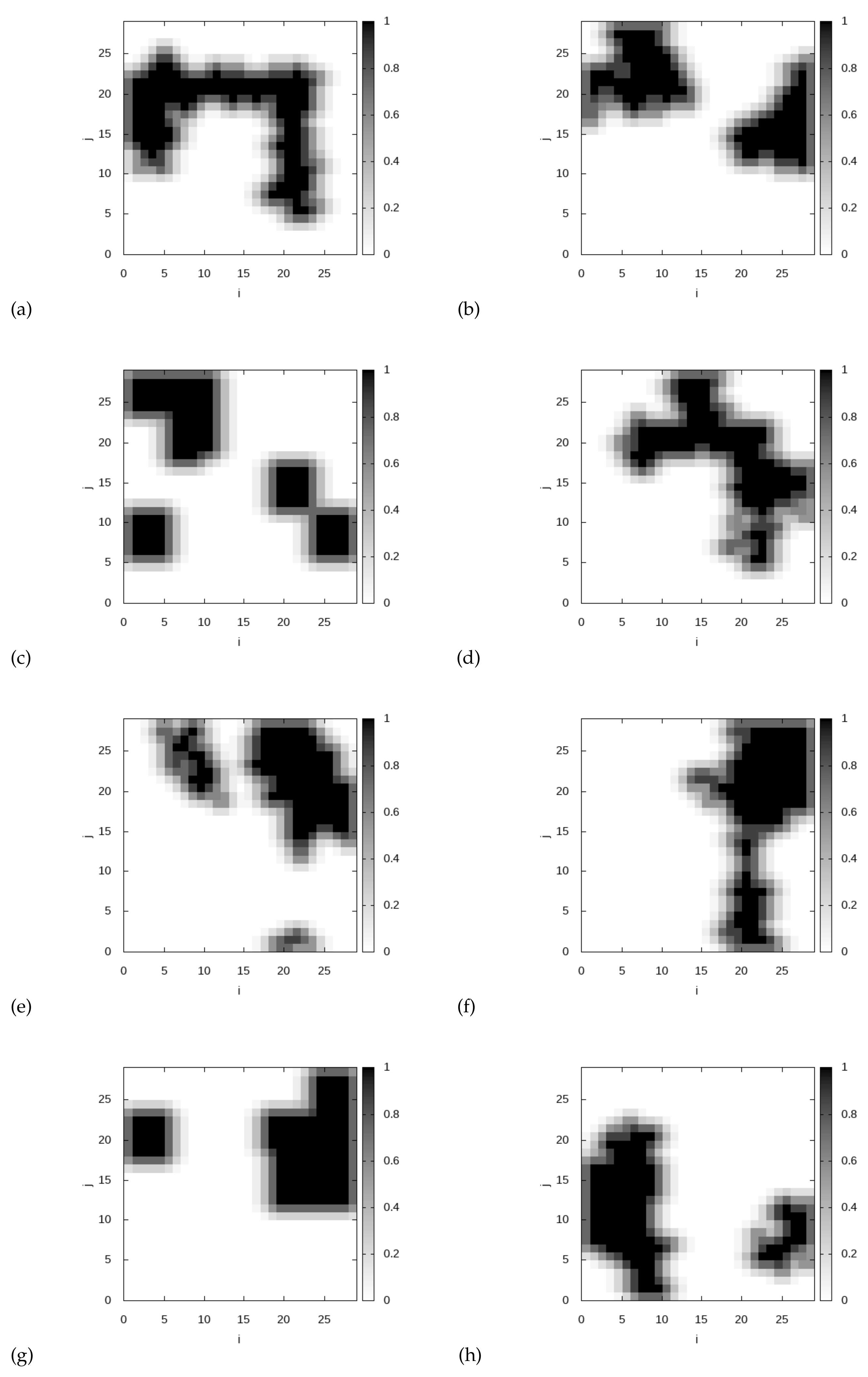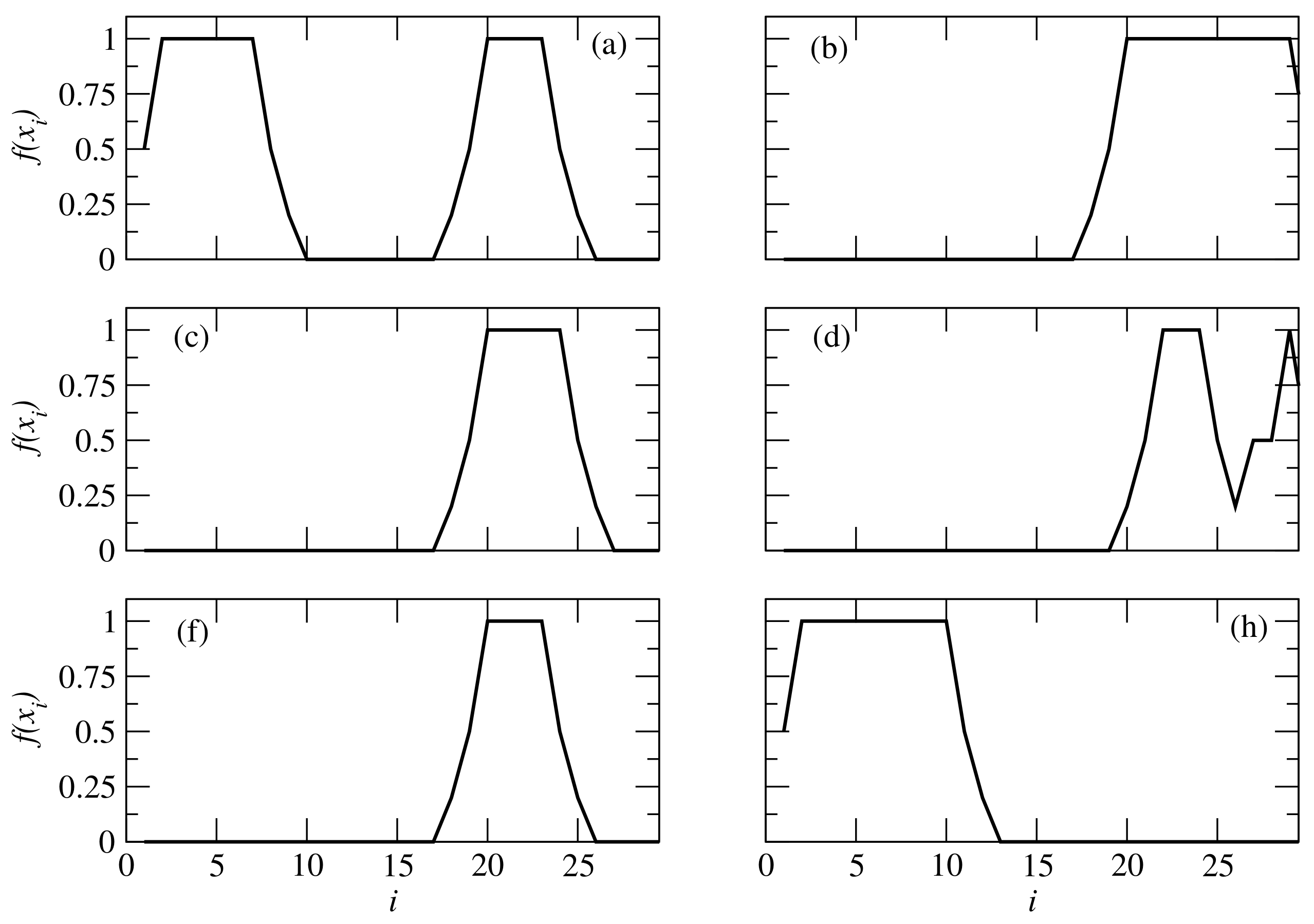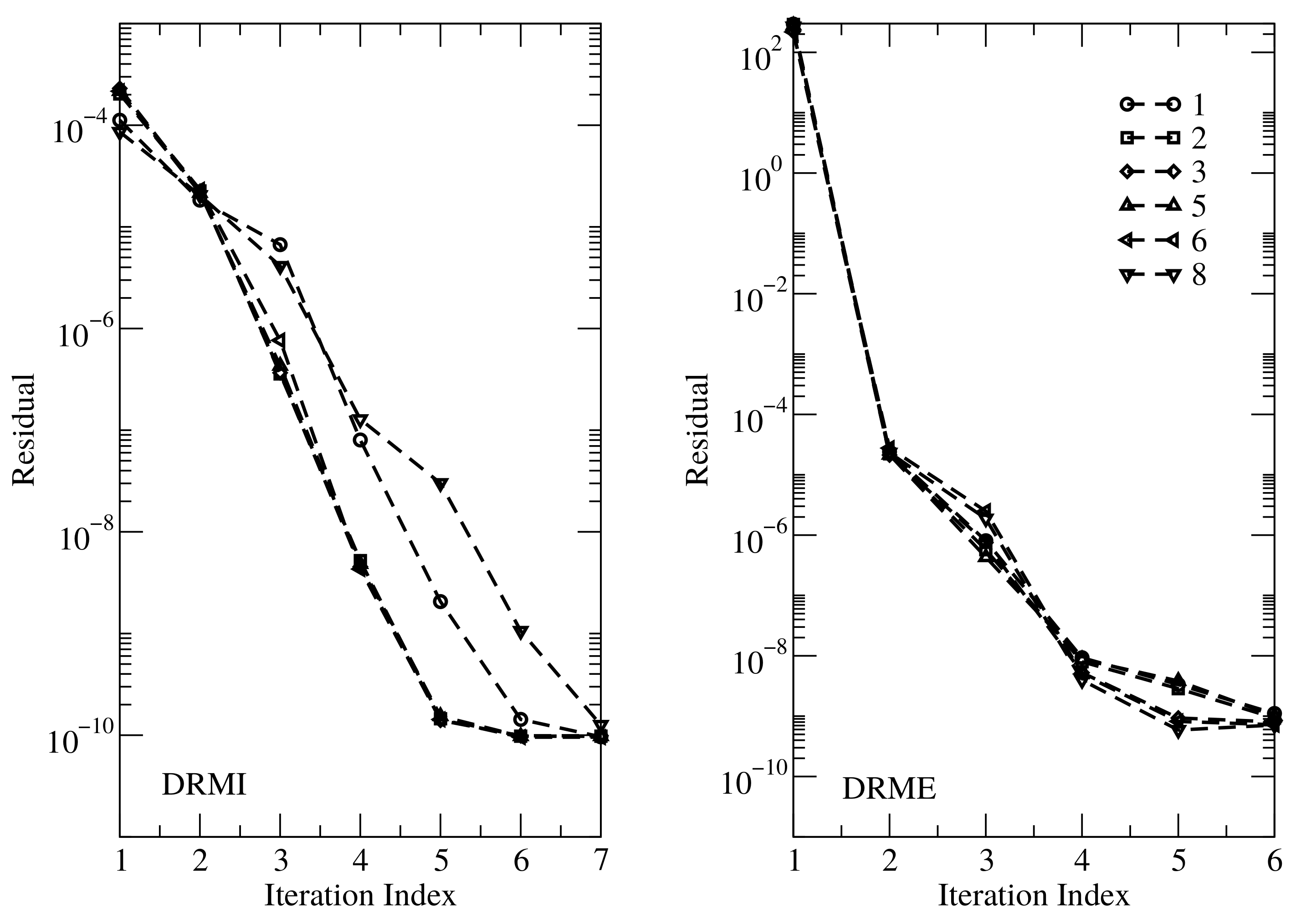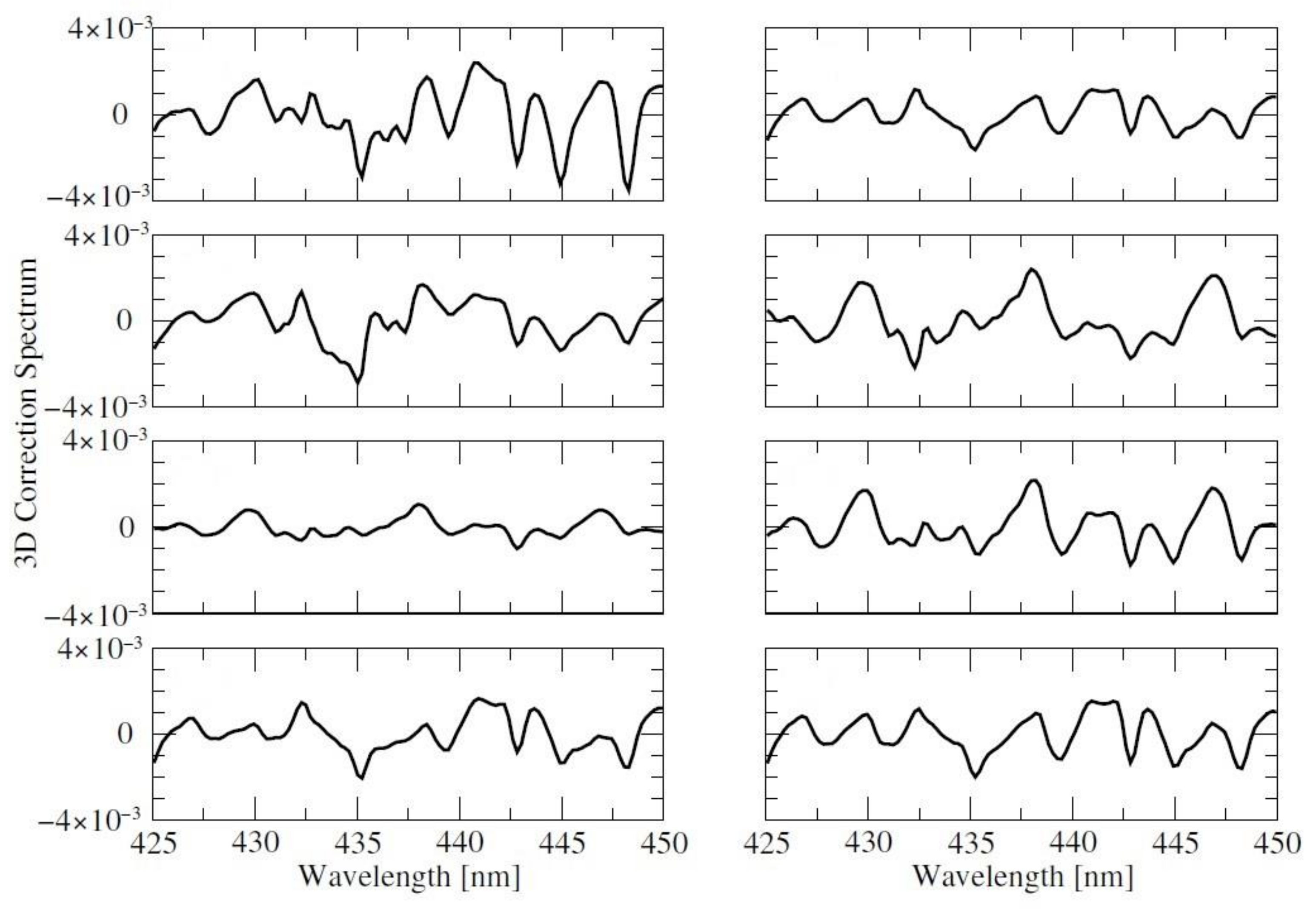A Proof-of-Concept Algorithm for the Retrieval of Total Column Amount of Trace Gases in a Multi-Dimensional Atmosphere
Abstract
1. Introduction
2. Retrieval Algorithm
- an inverse model,
- a solution method for solving the inverse problem, and
- a linearized multi-dimensional radiative transfer model for computing the forward model and the Jacobian matrix at each iteration step.
2.1. Inverse Models
- the Differential Radiance Model with Internal closure (DRMI), in which the measured and simulated differential spectral signals are fitted, and
- the Differential Radiance Model with External closure (DRME), in which the measured differential spectral signal and a simulated spectral signal with its smooth component extracted are fitted.
- In DRME, we assume the linearized model [19]where the second term in the right-hand side of the equation describes the variations of with respect to the total column amounts of trace gases with , and the third term comprises the contributions of all other atmospheric parameters. Approximating by a smoothing polynomial, i.e., , and putting , we are led to the linear equationwhich is equivalent with the Differential Optical Absorption Spectroscopy (DOAS) equation [18]. This equivalence is proved in Appendix B.
- We adopt an approximate inverse model in which we compute the spectral signal by an one-dimensional radiative transfer model, and (similar to the Ring and polarization correction spectra) introduce a correction spectrum that accounts on three-dimensional effects. To define the correction spectrum, we take into account that, for example, in DRME, we can writewhere and , are the spectral signals computed by a three- and an one-dimensional radiative transfer model, respectively, andis a relative correction spectrum. In deriving Equation (16), we used the first-order Taylor approximation for , and the decomposition , in which, the coefficients are uniquely determined by (see below), while the coefficients are unknown (as the coefficients are). In view of Equation (16), we assume that in the retrieval, the differential spectral termcan be described by , whereis the (differential) correction spectrum due to three-dimensional effects, the associated smoothing polynomial, and the amplitude of the correction spectrum (to be included in the retrieval). From Equation (18), we see that the correction spectrum reproduces the differential structure of the relative correction spectrum .
2.2. Solution Method
- In contrast to the method of Tikhonov regularization [22], the regularization parameter is not constant during the iterative process. Instead, the regularization parameters are the terms of a decreasing (geometric) sequence, i.e., with . In this way, the amount of regularization is gradually decreased during the iterative process.
- For iterative regularization methods, the number of iteration steps k plays the role of the regularization parameter, and the iterative process is stopped after an appropriate number of steps in order to avoid an uncontrolled expansion of the errors in the data. The stopping rule used in this study is the discrepancy principle [23], according to which, the iterative process is terminated after steps such thatwhere is the residual vector at , a control parameter, and the noise level (an upper bound for the noise in the data). Because in practice the noise level cannot be a priori estimated, we adopt a practical approach based on the observation that the residual decreases during the iterative process and attains a plateau at approximately . Thus, if the nonlinear residuals converge to within a prescribed tolerance, we use the estimate .
- The regularization matrix is chosen as a diagonal matrix, that is, the penalty term is taken asfor DRMI andfor DRME. Here, the scalars , , and give the weight of each component of the state vector into the regularization matrix.
2.3. Linearized Radiative Transfer Model
- The linearized forward approach relies on an analytical computation of the derivatives. The method is accurate and has the advantage that no assumptions rather than those of the forward model have to be made. However, the method is time consuming and memory demanding when the number of parameters to be retrieved is large. The reason is that not only the source function has to be stored as a spherical harmonic series at each grid point, but also its derivatives with respect to the atmospheric parameters of interest.
- The linearized forward-adjoint approach relies on the application of the adjoint radiative transfer theory. The method requires less storage for derivatives calculation, is much faster, but relatively less accurate. The main reason for this lower accuracy is that different interpolation schemes are used for radiance and derivative calculations.
- Correlated k-distribution method. Consider a discretization of the spectral interval into a set of equally spaced wavelengths with the discretization step , and assume that the transmission within a spectral interval depends only on the distribution of the gas absorption coefficient within the spectral interval [28]. Letting be the cumulative density function of in the spectral interval , the inverse distribution function, and a set of quadrature points and weights in the interval , the spectral signal (1) and its partial derivative with respect to the total column are computed aswhere , , and for , , , and Thus, in the framework of the correlated k-distribution method, W monchromatic radiative transfer calculations are required for computing and , and so, and . A further acceleration can be achieved when and are computed by using dimensionality reduction techniques, as for example, the principal component analysis.
- Principal component analysis. At wavelength , the integrated signal is related to the integrated signal calculated by a simplified (approximate) radiative transfer model through the relationi.e.,The correction factor in Equation (32) is actually the quantity that is calculated by means of the principal component analysis. To summarize this approach, we assume that for each wavelength , the spectral variability of the optical parameters can be described by a vector , defined bywhere and are the optical coefficients in the kth level, , and is the number of altitude levels. Denoting by the sample mean of the data, the aim is to find an M-dimensional subspace () spanned by a set of linear independent vectors , such that the centered data belong to this subspace, i.e., yielding for , where , is the pseudoinverse of , and is the kth component of the vector of parameters . In the principal component analysis, the original N-dimensional data are projected on the M-dimensional subspace spanned by the dominant singular vectors of the data covariance matrix , that is, with and being the kth singular value and vector of the matrix , we choose and , where and . Furthermore, approximating the correction factor by a second-order Taylor expansion around , and the gradient and the Hessian of f by central differences, we are led to the computational formulaTo compute the derivative of the integrated signal with respect to the total column , we may use the principal component analysis to calculate the derivative correction factor , defined by [29]in which case, we haveAlternatively, taking the derivative of Equation (33) with respect to , i.e.,we may use the principal component analysis to calculate the derivative correction factor , defined by
3. Numerical Simulations
- The domain of analysis is a rectangular prism of lengths km and km. The discretization steps along the horizontal directions are km. Along the vertical direction, the atmosphere between 0 and 50 km is discretized with a step of 0.5 km between 0 and 3 km, 0.1 km between 3 and 4 km, 0.5 km between 4 and 10 km, 1.0 km between 10 and 14 km, 2 km between 14 and 30 km, and 5 km between 30 and 50 km.
- A homogeneous cloud is placed between 3 and 4 km. The cloud extinction field is given by , where and is the indicator function (note that takes the values 1 and 0 inside and outside the cloud, respectively). The cloud phase function is a Henyey–Greenstein phase function [30] with the asymmetry parameter , and the cloud single-scattering albedo is 0.99. Eight cloudy scenes are generated by a two-dimensional broken cloud model [14] with a cloud fraction of about The extinction field is smoothed at the boundary of a cloudy region in order to avoid abrupt changes in the horizontal plane. The indicator functions corresponding to the eight cloudy scenes are illustrated in Figure 1a–h. For two-dimensional geometries, slices at km are selected from the cloud fields 1, 2, 3, 5, 6, and 8. The corresponding indicator functions are shown in Figure 2. Note that the slices corresponding to the cloudy scenes 4 and 7 are similar to the slice corresponding to the cloudy scene 2, and are therefore omitted.
- The number of discrete zenith and azimuth angles are and , respectively, the solar and instrument zenith angles are and , respectively, and the relative azimuth angle is .
- A Lambertian reflecting surface with the surface albedo is considered.
- The footprint of the detector is a square of length centered at , and , and a wavelength-dependent slit function corresponding to the TROPOMI instrument is assumed.
- In addition to the scattering and absorption by the cloud, molecular Rayleigh scattering and the absorption by , ozone (), oxygen dimer (), and water vapor () are considered. The measurement spectral grid roughly resembles the TROPOMI’s spectral resolution and consists of 119 spectral points between 425 nm and 450 nm.
- For a clean scenario, we use the a priori partial column profile of [17] illustrated in Figure 3 to generate the true (exact) partial column profile. In this regard, denoting the a priori partial columns of gas g by , we choose the true partial columns as , with and . The true total column of gas g is then computed as ; thus, .
- For , we generate the simulated spectral signal by means of SHDOM.
- For cubic smoothing polynomials, i.e., , we determine the coefficients of the polynomial as the solutions of the least-squares problem (13).
- We compute the noisy spectral signal as , where the measurement errors are assumed to be independent Gaussian random variables with zero mean and standard deviation , where SNR is the signal-to-noise ratio. It should be pointed out that in view of the approximationthe error in is yielding for all k. In other words, the measurement error vector is white noise with the covariance matrix , where is the identity matrix. Because in our simulations we are mainly interested in multi-dimensional effects, we take , that is, we assume an almost perfect instrument and neglect the forward model errors.
- We include the Ring correction spectrum illustrated in Figure 4 in the retrieval, and choose the a priori and true Ring amplitudes as and , respectively. Note that the inelastic scattering is described by a first-order Rayleigh scattering model, i.e., by applying a first-order iteration scheme to the one-dimensional radiative transfer equation for inelastic scattering [31].
- For DRMI, we compute the measured differential spectral signal aswhile for DRME, we choose and compute the measured differential spectral signal as
- an adaptive grid with a splitting accuracy of ,
- the principal component analysis with , and the derivative correction factor as in Equation (39),
- periodic boundary conditions,
- The regularization parameters are the terms of a geometric sequence with ratio and initial value . Thus, at the first iteration step, the regularization parameter is .
- The weighting factors specifying the contribution of each component of the state vector into the regularization matrix are , , , and for all . By this choice, the total columns of the auxiliary gases are stronger constrained to the a priori than the total column of and the Ring correction spectrum.
- The control parameter in the discrepancy principle Equation (24) is .
3.1. Test Example 1
- the inverse problem is severely ill-posed (for the DRMI model, the condition number of the Jacobian matrix at the initial guess is ) and
- there is a strong correlation between the and Ring effect signatures (when the Ring correction spectrum is not included in the retrieval, the condition number is ; thus, decreases by three order of magnitude).
- At the initial guess, the residual corresponding to DRMI is much smaller than that corresponding to DRME. This occurs because the discrepancies between the differential spectra are usually small.
- In DRMI, the residual decreases very fast at the first iteration step and then more steadily, while in DRME, the residual gradually decreases.
3.2. Test Example 2
4. Discussion
- The differential radiance models with internal and external closures yield accurate results with reasonable computation times (of about 35–40 min).
- An inverse model based on an approximate computation of the partial derivative leads to a reduction of the computation time by about 25%, but to large relative errors.
- Provided that the regularization parameter is optimally chosen, reasonable accurate results with a computation time of about 6 min can be obtained when the iterative process, corresponding to the differential radiance model with external closure, is stopped after one iteration step. The fact that the optimal value of the regularization parameter depends on the cloudy scene, makes it more difficult to apply this one-step retrieval algorithm, or equivalently, DOAS-type models.
- Although accurate, the retrievals based on the differential radiance model with external closures are inefficient; the computation time is of about 14 h and 15 min for a full-step retrieval algorithm, and 2 h and 30 min for an one-step retrieval algorithm. The one-step retrieval algorithm is less accurate than in the case of two-dimensional geometries, but the results are still acceptable.
- The application of a fast one-dimensional radiative transfer model to retrieve the column amount for a three-dimensional cloudy scene leads to relative errors up to 15%. These errors can be reduced when a differential correction spectrum due to three-dimensional effects is included in the retrieval.
- to construct a database for the spectral signal and its derivatives , and to use these spectra in an one-step, three-dimensional retrieval algorithm, or
- to construct a database for the differential correction spectra accounting on three-dimensional effects , and to use these spectra in a full-step, one-dimensional retrieval algorithm.
Author Contributions
Funding
Conflicts of Interest
Appendix A
- With delivered by the reference sector method, and and determined at Step 1, solve the nonlinear equationof the DRMI inversion model for , or the nonlinear equationof the DRME inversion model for .
Appendix B
References
- Efremenko, D.S.; Doicu, A.; Loyola, D.; Trautmann, T. Fast Stochastic Radiative Transfer Models for Trace Gas and Cloud Property Retrievals Under Cloudy Conditions. In Springer Series in Light Scattering; Kokhanovsky, A., Ed.; Springer International Publishing: Cham, Switzerland, 2018; pp. 231–277. [Google Scholar] [CrossRef]
- Belov, V.V.; Kirnos, I.V.; Tarasenkov, M.V. Estimation of the influence of cloudiness on the Earth observation from space through a gap in a cloudy field. In Proceedings of the 21st International Symposium Atmospheric and Ocean Optics: Atmospheric Physics, SPIE, Tomsk, Russia, 22–26 June 2015; Romanovskii, O.A., Ed.; [Google Scholar] [CrossRef]
- Tarasenkov, M.V.; Kirnos, I.V.; Belov, V.V. Observation of the Earth’s surface from the space through a gap in a cloud field. Atmos. Ocean. Opt. 2017, 30, 39–43. [Google Scholar] [CrossRef]
- Zhuravleva, T.B.; Nasrtdinov, I.M.; Russkova, T.V. Influence of 3D cloud effects on spatial-angular characteristics of the reflected solar radiation field. Atmos. Ocean. Opt. 2017, 30, 103–110. [Google Scholar] [CrossRef]
- Schwaerzel, M.; Emde, C.; Brunner, D.; Morales, R.; Wagner, T.; Berne, A.; Buchmann, B.; Kuhlmann, G. Three-dimensional radiative transfer effects on airborne and ground-based trace gas remote sensing. Atmos. Meas. Tech. 2020, 13, 4277–4293. [Google Scholar] [CrossRef]
- Evans, K. The spherical harmonic discrete ordinate method for three-dimensional atmospheric radiative transfer. J. Atmos. Sci. 1998, 55, 429–446. [Google Scholar] [CrossRef]
- Cracknell, A.; Hayes, L. Introduction to Remote Sensing, 2nd ed.; CRC Press: New York, NY, USA, 2007. [Google Scholar]
- Chandrasekhar, S. Radiative Transfer. In Dover Books on Intermediate and Advanced Mathematics; Dover Publications: New York, New York, USA, 1960. [Google Scholar]
- Sobolev, V.V. Light Scattering in Planetary Atmospheres; Pergamon Press: New York, USA, 1972. [Google Scholar]
- Doicu, A.; Efremenko, D.; Trautmann, T. An analysis of the short-characteristic method for the spherical harmonic discrete ordinate method (SHDOM). J. Quant. Spectrosc. Radiat. Transf. 2013, 119, 114–127. [Google Scholar] [CrossRef]
- Bohren, C.; Huffman, D. Absorption and Scattering of Light by Small Particles; Wiley: New York, NY, USA, 1998. [Google Scholar] [CrossRef]
- Kokhanovsky, A. Cloud Optics; Springer: Dordrecht, The Netherlands, 2006. [Google Scholar] [CrossRef]
- Bodhaine, B.; Wood, N.; Dutton, E.; Slusser, J. On Rayleigh optical depth calculations. J. Atmos. Ocean. Technol. 1999, 16, 1854–1861. [Google Scholar] [CrossRef]
- Alexandrov, M.; Marshak, A.; Ackerman, A. Cellular Statistical Models of Broken Cloud Fields. Part I: Theory. J. Atmos. Sci. 2010, 67, 2125–2151. [Google Scholar] [CrossRef]
- Doicu, A.; Trautmann, T.; Schreier, F. Numerical Regularization for Atmospheric Inverse Problems; Springer: Berlin/Heidelberg, Germany, 2010. [Google Scholar] [CrossRef]
- Efremenko, D.; Schüssler, O.; Doicu, A.; Loyola, D. A stochastic cloud model for cloud and ozone retrievals from UV measurements. J. Quant. Spectrosc. Radiat. Transf. 2016, 184, 167–179. [Google Scholar] [CrossRef]
- Liu, S. Inversion Models for the Retrieval of Total and Tropospheric NO2 Columns. Atmosphere 2019, 10, 607. [Google Scholar] [CrossRef]
- Platt, U.; Stutz, J. Differential Optical Absorption Spectroscopy; Springer: Berlin/Heidelberg, Germany, 2008. [Google Scholar] [CrossRef]
- Rozanov, V.V.; Rozanov, A.V. Differential optical absorption spectroscopy (DOAS) and air mass factor concept for a multiply scattering vertically inhomogeneous medium: Theoretical consideration. Atmos. Meas. Tech. 2010, 3, 751–780. [Google Scholar] [CrossRef]
- Bakushinskii, A. The problem of the convergence of the iteratively regularized Gauss–Newton method. Comput. Math. Math. Phys. 1992, 32, 1353–1359. [Google Scholar]
- Xu, J.; Rao, L.; Schreier, F.; Efremenko, D.; Doicu, A.; Trautmann, T. Insight into Construction of Tikhonov-Type Regularization for Atmospheric Retrievals. Atmosphere 2020, 11, 1052. [Google Scholar] [CrossRef]
- Tikhonov, A. On the solution of ill-posed problems and the method of regularization. Dokl. Akad. Nauk SSSR 1963, 151, 501–504. [Google Scholar]
- Morozov, V. On the solution of functional equations by the method of regularization. Dokl. Akad. Nauk SSSR 1966, 167, 510–512. [Google Scholar]
- Spherical Harmonic Discrete Ordinate Method (SHDOM) for Atmospheric Radiative Transfer. Available online: http://coloradolinux.com/shdom/ (accessed on 3 January 2020).
- Doicu, A.; Efremenko, D. Linearizations of the Spherical Harmonic Discrete Ordinate Method (SHDOM). Atmosphere 2019, 10, 292. [Google Scholar] [CrossRef]
- Levis, A.; Schechner, Y.; Aides, A.; Davis, A. Airborne Three-Dimensional Cloud Tomography. In Proceedings of the 2015 IEEE International Conference on Computer Vision (ICCV), Santiago, Chile, 7–13 December 2015. [Google Scholar] [CrossRef]
- Doicu, A.; Efremenko, D.; Trautmann, T. A Spectral Acceleration Approach for the Spherical Harmonics Discrete Ordinate Method. Remote Sens. 2020, 12, 3703. [Google Scholar] [CrossRef]
- Ambartzumyan, V. The effect of the absorption lines on the radiative equilibrium of the outer layers of the stars. Publ. Obs. Astron. Univ. Leningrad 1936, 6, 7–18. [Google Scholar]
- Efremenko, D.; Doicu, A.; Loyola, D.; Trautmann, T. Optical property dimensionality reduction techniques for accelerated radiative transfer performance: Application to remote sensing total ozone retrievals. J. Quant. Spectrosc. Radiat. Transfer. 2014, 133, 128–135. [Google Scholar] [CrossRef]
- Henyey, L.C.; Greenstein, J.L. Diffuse radiation in the Galaxy. Astrophys. J. 1941, 93, 70. [Google Scholar] [CrossRef]
- Rozanov, V.; Vountas, M. Radiative transfer equation accounting for rotational Raman scattering and its solution by the discrete-ordinates method. J. Quant. Spectrosc. Radiat. Transf. 2014, 133, 603–618. [Google Scholar] [CrossRef]
- Wiscombe, W. The delta-M method: Rapid yet accurate radiative flux calculations for strongly asymmetric phase functions. J. Atmos. Sci. 1977, 34, 1408–1422. [Google Scholar] [CrossRef]
- Nakajima, T.; Tanaka, M. Algorithms for radiative intensity calculations in moderately thick atmos using a truncation approximation. J. Quant. Spectrosc. Radiat. Transfer. 1988, 40, 51–69. [Google Scholar] [CrossRef]
- Várnai, T.; Davies, R. Effects of Cloud Heterogeneities on Shortwave Radiation: Comparison of Cloud-Top Variability and Internal Heterogeneity. J. Atmos. Sci. 1999, 56, 4206–4224. [Google Scholar] [CrossRef]
- Richter, A.; Burrows, J. Tropospheric NO2 from GOME measurements. Adv. Space Res. 2002, 29, 1673–1683. [Google Scholar] [CrossRef]
- Bucsela, E.J.; Krotkov, N.A.; Celarier, E.A.; Lamsal, L.N.; Swartz, W.H.; Bhartia, P.K.; Boersma, K.F.; Veefkind, J.P.; Gleason, J.F.; Pickering, K.E. A new stratospheric and tropospheric NO2 retrieval algorithm for nadir-viewing satellite instruments: Applications to OMI. Atmos. Meas. Tech. 2013, 6, 2607–2626. [Google Scholar] [CrossRef]
- Beirle, S.; Hörmann, C.; Jöckel, P.; Liu, S.; de Vries, M.; Pozzer, A.; Sihler, H.; Valks, P.; Wagner, T. The STRatospheric Estimation Algorithm from Mainz (STREAM): Estimating stratospheric NO2 from nadir-viewing satellites by weighted convolution. Atmos. Meas. Tech. 2016, 9, 2753–2779. [Google Scholar] [CrossRef]






| Cloudy Scene | DRMI | DRMI Approx. Derivatives | ||
|---|---|---|---|---|
| Rel. Errors | CPU | Rel. Errors | CPU | |
| 1 | 39:51 | 32:24 | ||
| 2 | 40:12 | 32:48 | ||
| 3 | 39:14 | 31:06 | ||
| 5 | 38:54 | 30:44 | ||
| 6 | 39:32 | 31:16 | ||
| 8 | 40:06 | 32:33 | ||
| Cloudy Scene | DRME | DRME (One Iteration) | ||
|---|---|---|---|---|
| Rel. Errors | CPU | Rel. Errors | CPU | |
| 1 | 35:10 | 5:33 | ||
| 2 | 36:47 | 5:54 | ||
| 3 | 34:57 | 5:12 | ||
| 5 | 34:23 | 5:01 | ||
| 6 | 35:06 | 5:28 | ||
| 8 | 36:23 | 5:48 | ||
| Cloudy Scene | DRME | DRME (One Iteration) | ||
|---|---|---|---|---|
| Rel. Errors | CPU | Rel. Errors | CPU | |
| 1 | 14:15:31 | 2:34:03 | ||
| 2 | 14:21:43 | 2:36:42 | ||
| 3 | 14:15:57 | 2:32:26 | ||
| 5 | 14:15:23 | 2:32:11 | ||
| 6 | 14:14:36 | 2:33:38 | ||
| 8 | 14:20:13 | 2:34:16 | ||
| Cloudy Scene | DRMI | DRMI (Correction. Spectrum) | ||
|---|---|---|---|---|
| Rel. Errors | CPU | Rel. Errors | CPU | |
| 1 | 2:21 | 2:42 | ||
| 2 | 2:32 | 2:58 | ||
| 3 | 2:14 | 2:36 | ||
| 4 | 2:04 | 2:24 | ||
| 5 | 2:27 | 2:47 | ||
| 6 | 2:25 | 2:45 | ||
| 7 | 2:25 | 2:46 | ||
| 8 | 2:30 | 2:50 | ||
| Cloudy Scene | DRME | DRME (Correction. Spectrum) | ||
|---|---|---|---|---|
| Rel. Errors | CPU | Rel. Errors | CPU | |
| 1 | 2:10 | 2:16 | ||
| 2 | 2:12 | 2:18 | ||
| 3 | 2:05 | 2:11 | ||
| 4 | 1:52 | 2:01 | ||
| 5 | 2:16 | 2:22 | ||
| 6 | 2:14 | 2:18 | ||
| 7 | 2:13 | 2:19 | ||
| 8 | 2:21 | 2:17 | ||
Publisher’s Note: MDPI stays neutral with regard to jurisdictional claims in published maps and institutional affiliations. |
© 2021 by the authors. Licensee MDPI, Basel, Switzerland. This article is an open access article distributed under the terms and conditions of the Creative Commons Attribution (CC BY) license (http://creativecommons.org/licenses/by/4.0/).
Share and Cite
Doicu, A.; Efremenko, D.S.; Trautmann, T. A Proof-of-Concept Algorithm for the Retrieval of Total Column Amount of Trace Gases in a Multi-Dimensional Atmosphere. Remote Sens. 2021, 13, 270. https://doi.org/10.3390/rs13020270
Doicu A, Efremenko DS, Trautmann T. A Proof-of-Concept Algorithm for the Retrieval of Total Column Amount of Trace Gases in a Multi-Dimensional Atmosphere. Remote Sensing. 2021; 13(2):270. https://doi.org/10.3390/rs13020270
Chicago/Turabian StyleDoicu, Adrian, Dmitry S. Efremenko, and Thomas Trautmann. 2021. "A Proof-of-Concept Algorithm for the Retrieval of Total Column Amount of Trace Gases in a Multi-Dimensional Atmosphere" Remote Sensing 13, no. 2: 270. https://doi.org/10.3390/rs13020270
APA StyleDoicu, A., Efremenko, D. S., & Trautmann, T. (2021). A Proof-of-Concept Algorithm for the Retrieval of Total Column Amount of Trace Gases in a Multi-Dimensional Atmosphere. Remote Sensing, 13(2), 270. https://doi.org/10.3390/rs13020270






